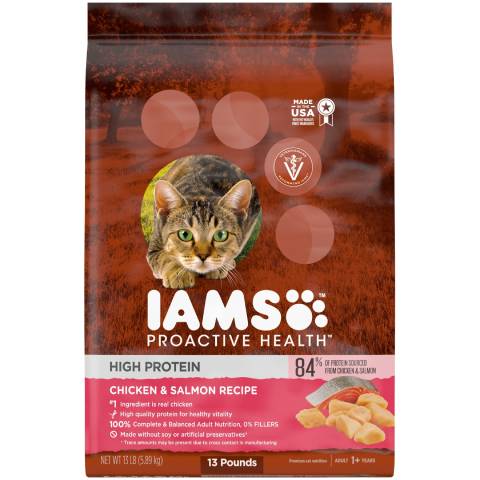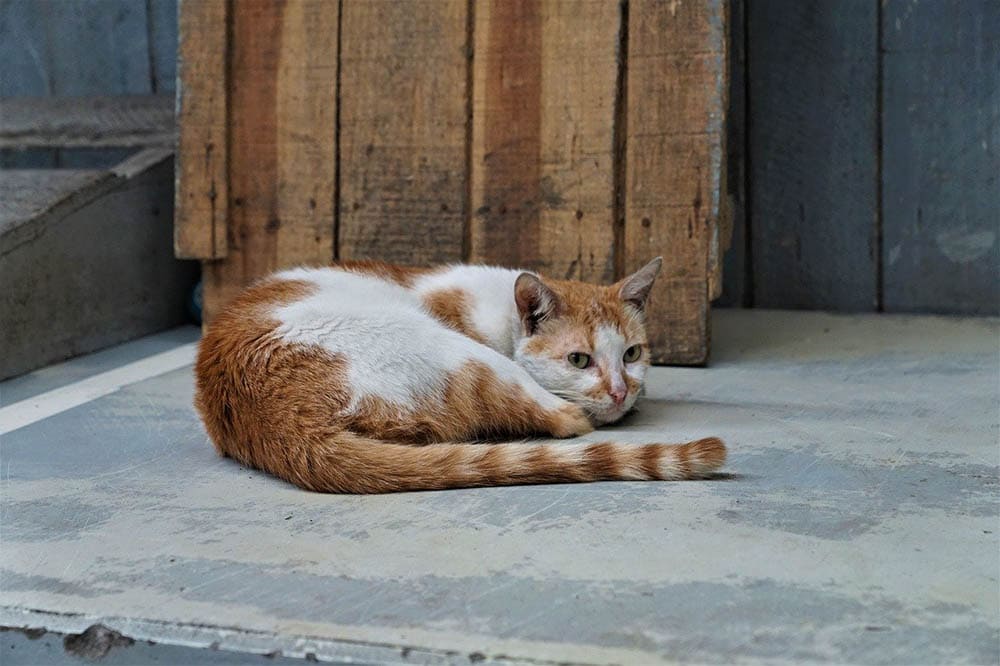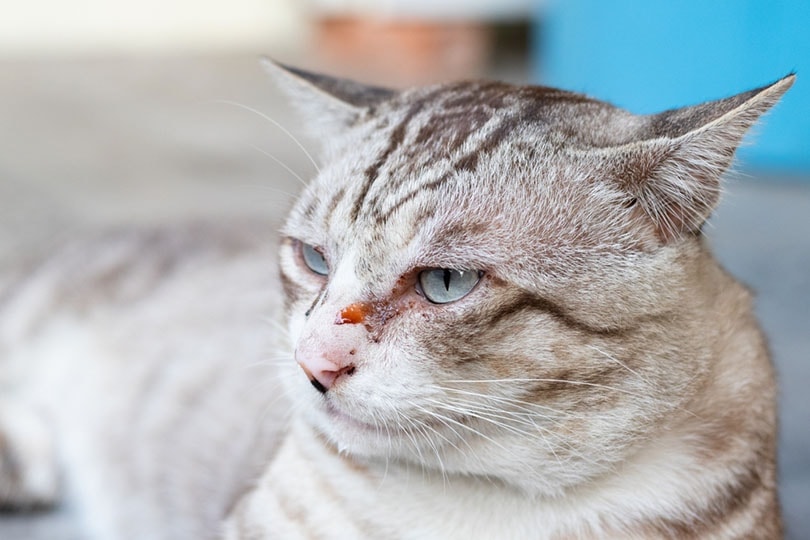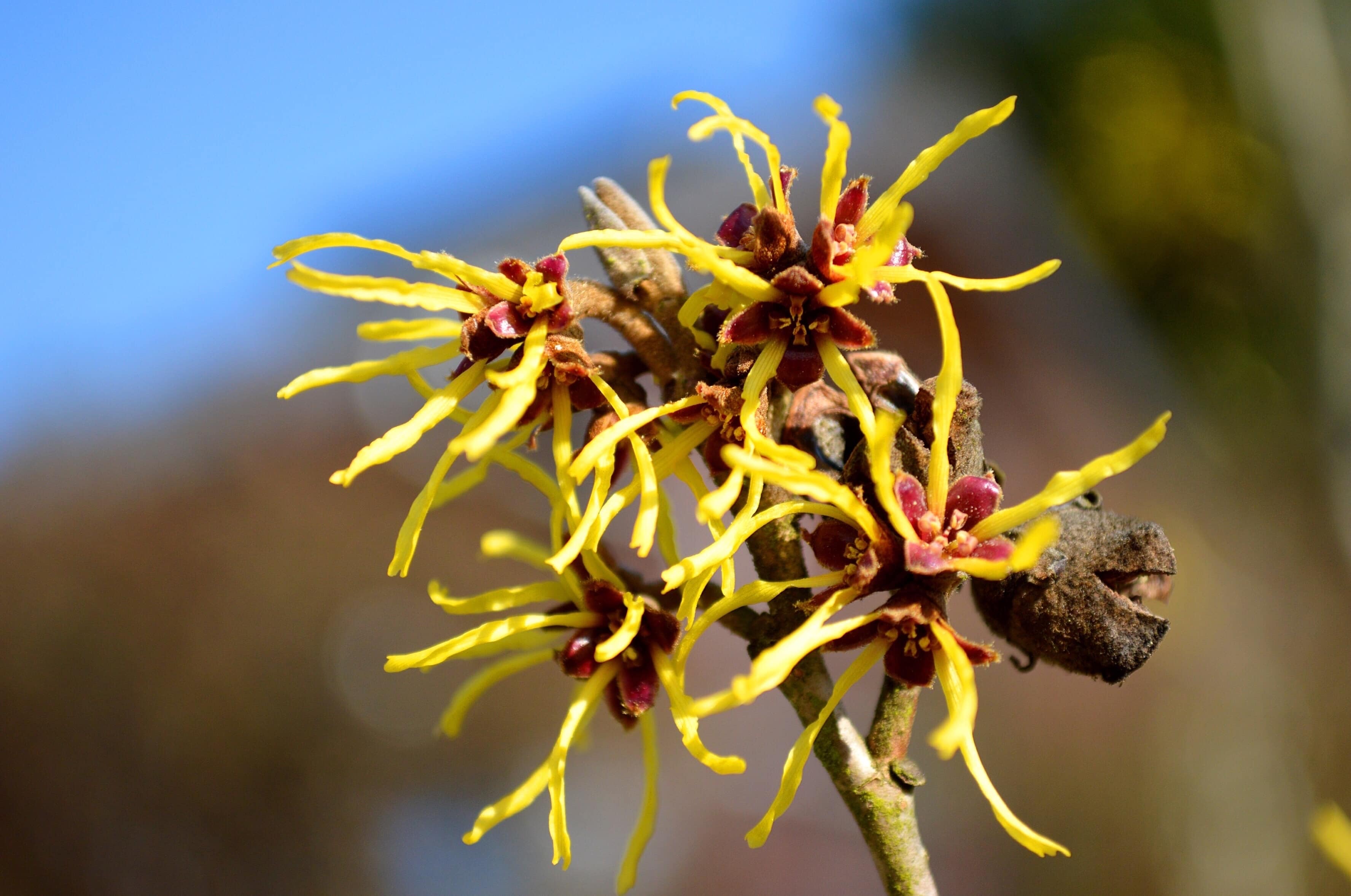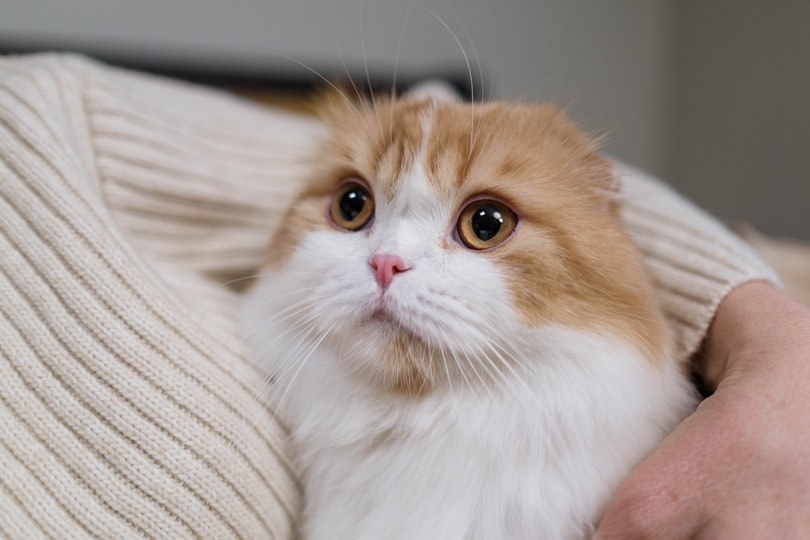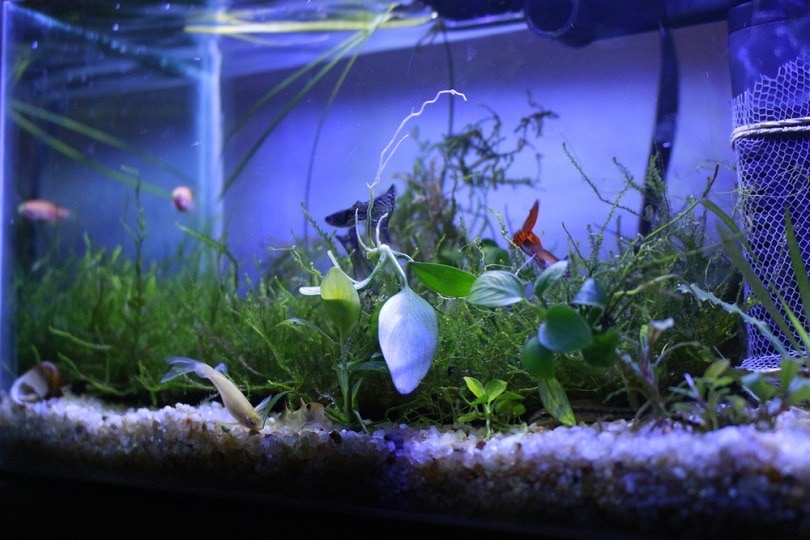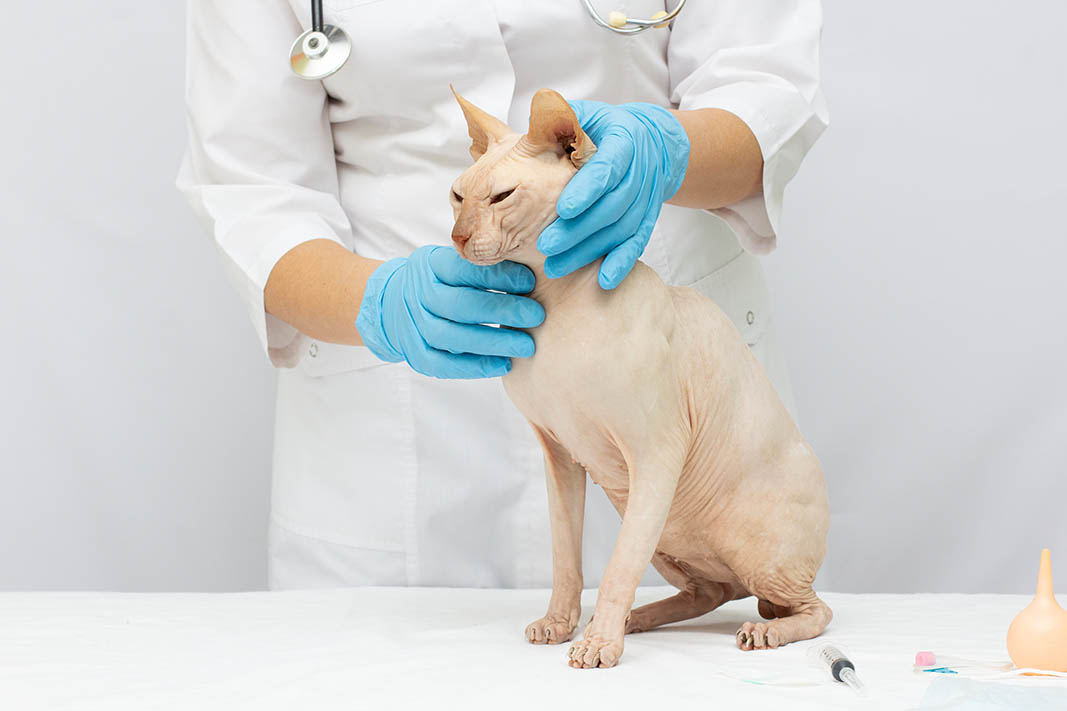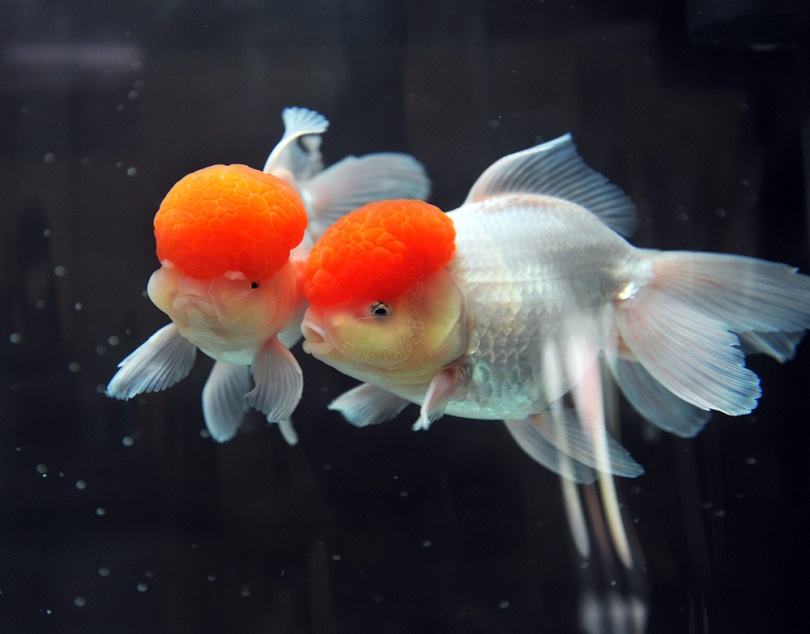11 Best High-Calorie Cat Foods for Weight Gain – 2024 Reviews and Top Picks
Updated on
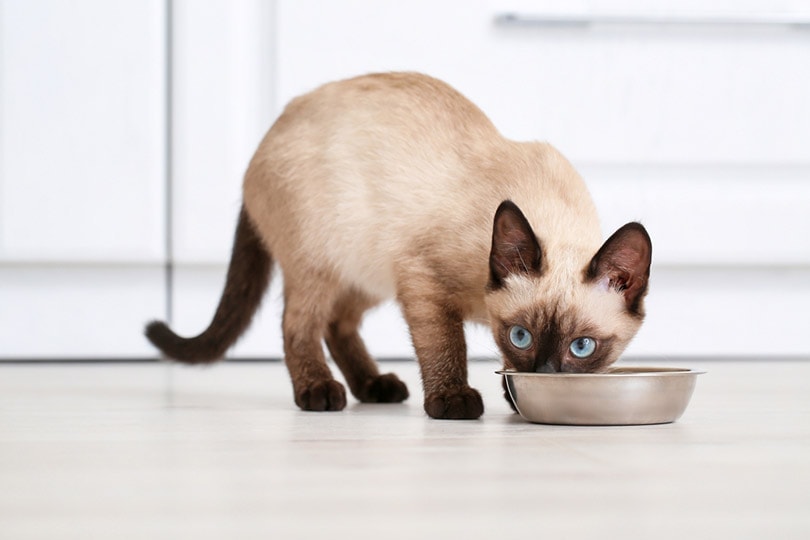
First things first: before you find the best food to help your cat gain weight, make sure you know why they lost it to begin with. The reasons why your cat may lose weight are many and varied. Until you deal with any underlying condition, the best high-calorie cat food money can buy won’t help your cat gain weight.
Once you and your veterinarian have diagnosed and treated whatever is causing the weight loss, it’s time to help your kitty start bulking up! To gain weight correctly, your cat needs to eat about 20% more calories than they normally would. We’ve rounded up reviews of the best high-calorie cat foods for weight gain. Hopefully, this information can help you and your veterinarian decide how to help your cat get back to a healthy size.
Disclaimer: The foods reviewed here were chosen because they have certain characteristics that might help with some of the causes or consequences of this medical condition. However, they are not a medical treatment or a substitute for medical treatment. Keep in mind that each medical case is different and what works for some pets may not work for others. Your veterinarian is the right person to advise you on the best diet for your pet’s individual case.
A Quick Look At Our Favorites in 2024
| Rating | Image | Product | Details | |
|---|---|---|---|---|
| Best Overall |

|
Smalls Fresh Cat Food Cow Recipe |
|
Click to Save 40% Use code: Hepper2023 |
| Budget Buy |

|
Iams Proactive High Protein Dry Cat Food |
|
Check Price |

|
Hill’s Prescription Diet Urgent Care Pet Food |
|
Check Price | |

|
Nutri-Cal Gel High-Calorie Supplement |
|
Check Price | |

|
Solid Gold Chicken & Eggs Dry Cat Food |
|
Check Price |
The 11 Best High-Calorie Cat Foods for Weight Gain
1. Smalls Fresh Cat Food Ground Cow Recipe – Best Overall
| Protein: | 15% |
| Fat: | 12% |
| Calories: | 1551 kcal/kg |
| Top ingredients: | Ground beef, beef liver, green beans, beef hearts |
Smalls is high-quality, fresh cat food delivered right to your door. They offer three flavors without any artificial ingredients or preservatives. You can find different food textures like smooth, pulled, or ground meat. Smalls isn’t considered high calorie, but it is high in protein and fat, which is great for cats that need to gain weight.
To get started, you complete a brief questionnaire about your cat, and they’ll send you a sample in the mail first. You have to sign up for a subscription before receiving the sample food which can be a hassle if you want to cancel your subscription. Something cat owners may not like is that the meals aren’t pre-portioned. For cats that need to gain weight, this may not be an issue as much. But you still don’t want your cat to overeat, so you’ll have to do the measuring yourself.
Ultimately, cat owners report better energy levels, shinier coats, fresher breath, less stinky litter boxes, and less vomiting with this fresh food. For added calories, you also have the option of adding a fish oil supplement to your cat’s diet under your vet’s supervision.
- Different textures to choose from
- High protein and fat
- No preservatives or artificial flavoring
- Clean ingredients
- Meals aren’t pre-portioned
2. Iams Proactive Health High Protein Dry Cat Food – Budget Buy
| Protein: | 38% |
| Fat: | 18% |
| Calories: | 439 kcal/cup |
| Top ingredients: | Chicken, Chicken by-product meal, corn grits |
As the best high-calorie cat food for weight gain for the money, we’ve selected Iams Proactive Health High Protein Chicken and Salmon dry food. Canned cat food is usually the best option when you’re trying to get your cat to gain weight because your cat gets more nutrients in a smaller amount of food. However, canned food is also more expensive than dry. If you need a high protein and calorie count in more affordable food, this Iams diet is a worthwhile option to consider. It contains two different protein sources and is highly digestible, helping to make sure your cat absorbs as much nutrition as possible.
Because it is a lower-cost option, this food does contain corn and chicken by-products, which aren’t necessarily unhealthy ingredients but some owners prefer to avoid them.
- Two different protein sources
- High calories per cup
- Affordable
- Contains some lower-quality ingredients
- Some cats don’t like fish-based foods
3. Hill’s Prescription Diet Urgent Care Wet Pet Food
| Protein: | 5% min |
| Fat: | 2% min |
| Calories: | 180 kcal/5.5-ounce can |
| Top ingredients: | Water, turkey, liver, pork liver |
Another excellent choice of high-calorie cat food is another prescription diet, Hill’s a/d Canned Food Urgent Care. This diet is similar in purpose to the Recovery RS but slightly more expensive. Like Recovery, this diet was developed with undernourished cats in mind. The texture is soft and the odor and taste are strong to entice cats with picky appetites. Hill’s a/d uses liver as its protein source. Organ meats such as the liver are high in many essential nutrients that can benefit cats trying to gain weight.
This food isn’t designed to be fed to healthy cats at a normal weight so don’t buy too much if your cat won’t need it for long.
- High in essential nutrients
- Soft enough to use in feeding tubes
- Most cats love the taste
- Expensive
- Slightly lower in calories than competitors
- Requires a prescription
4. Nutri-Cal Gel High-Calorie Supplement
| Protein: | 2% |
| Fat: | 30% |
| Calories: | 28 kcal/teaspoon |
| Top ingredients: | Corn syrup, soybean oil, malt syrup |
The best high-calorie food for kittens is technically a supplement rather than a complete diet but for kittens who are struggling to thrive, Nutri-Cal can be life-saving. Kittens, especially sick or underweight ones, can have trouble keeping their blood sugar at a safe level. Low blood sugar, or hypoglycemia, can be life-threatening. Small amounts of Nutri-Cal can give a kitten who’s not eating well a quick shot of calories and energy, helping keep their blood sugar normal. Nutri-Cal can also provide extra calories and fat to older cats trying to gain weight.
Because it’s not a complete diet, you can’t feed just Nutri-Cal to your cat long-term. For underweight kittens, the goal is to get them to survive long-term and Nutri-Cal is effective at helping achieve that goal.
- A quick source of calories for kittens
- Easy to feed
- High in vitamins
- Not a complete diet
- Can be messy and sticky
5. Solid Gold Chicken & Eggs High-Protein Cat Food
| Protein: | 42% |
| Fat: | 20% |
| Calories: | 475 kcal/cup |
| Top ingredients: | Chicken meal, potatoes, canola oil |
This Solid Gold Chicken and Egg dry food offers one of the highest protein, fat, and calories per cup of any kibble diet. If your underweight cat can eat dry food, this is one of the most nutrient-dense options to offer. Both grain and gluten-free, this food is also made with all-natural, cage-free chicken for those owners who prioritize those types of food standards. This food does have a carbohydrate—potatoes—high on the ingredient list. While cats can digest and use carbs in their diet, many owners prefer cat foods with more meat sources as top ingredients.
This food is more expensive than other dry food options and some cats don’t like the crumbly texture.
- Nutrient-dense
- Made with cage-free chicken
- Grain-free
- Expensive
- Texture doesn’t appeal to all cats
6. Royal Canin Recovery Canned Cat Food
| Protein: | 4% |
| Fat: | 2% |
| Calories: | 163 kcal/1-ounce can |
| Top ingredients: | Water sufficient for processing, chicken, chicken liver |
Another great high-calorie food for weight gain in cats is the Royal Canin Recovery canned food. This is a prescription, veterinary diet designed to provide extra nutritional support to cats who are recovering from illness or who need added calories and protein for other reasons. The texture and taste especially appeal to cats with poor or picky appetites. Recovery RS packs a high-calorie content into each can, ensuring that even if your cat only eats a small amount, they get as much nutrition as possible.
This canned food also mixes easily into dry diets or with other canned foods to add a little extra calorie kick. The downside of this diet is it does require a veterinary prescription and it is expensive compared to other options.
- Specifically formulated for weight gain
- Easy texture to chew and swallow
- Requires a prescription
- Expensive
7. Purina ProPlan Chicken Kitten Entree Cat Food
| Protein: | 12% |
| Fat: | 6% |
| Calories: | 112 kcal/3-ounce can |
| Top ingredients: | Chicken, liver, water sufficient for processing |
When it comes to non-prescription diets for weight gain, kitten food is often recommended because it’s designed with higher calories and protein to boost growth. Purina ProPlan Savor Classic Chicken food is a strong choice thanks to its extra high protein and fat. Like Hill’s a/d, it uses liver as a protein source but the price of this diet is much more affordable. ProPlan Savor comes in a smaller can than the Recovery or Hill’s but still packs a high-calorie count. This diet will also appeal to owners who prefer feeding grain-free diets.
Some cats may not like the taste and texture of this food compared to some of the other choices.
- Affordable
- High protein and fat content
- Grain-free
- Small can
- The taste may not appeal to all cats
8. Wellness Core Turkey & Chicken Liver Kitten Food
| Protein: | 12% |
| Fat: | 5% |
| Calories: | 108 kcal/3-ounce can |
| Top ingredients: | Turkey, chicken liver, turkey broth |
Meat ingredients are first, second, and third on the list for Wellness Core Grain-free Kitten food. That and the lack of grains, by-products, and any artificial ingredients are the major selling points of this high-calorie food option. This food has a higher fat content, but a lower calorie per can than the Purina ProPlan diet we just reviewed. Wellness Core is slightly more affordable, however.
Some cats don’t seem to like the taste of this food so keep that in mind if you are buying for a cat who’s already picky or still getting their appetite back. It does come in both a small 3-ounce can and a larger 5.5-ounce can if it turns out your cat is a fan of this food.
- Prioritizes natural ingredients
- Two can sizes to choose from
- Not all cats like the taste
9. Purina One High Protein Grain-free Dry Cat Food
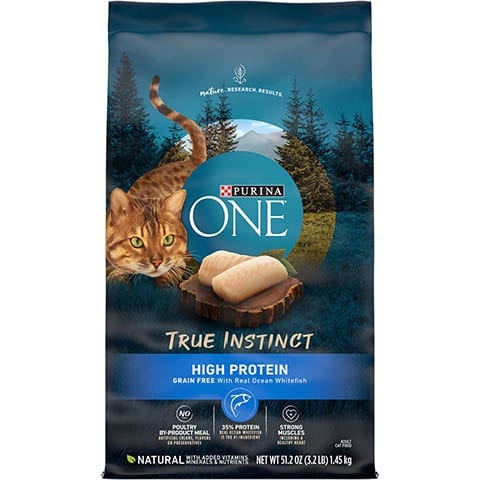
| Protein: | 35% |
| Fat: | 14% |
| Calories: | 365 kcal/cup |
| Top ingredients: | Chicken, Chicken meal, pea starch |
This dry food is an affordable option that uses higher quality ingredients than some other value-priced foods. Purina One True Instinct has lower protein and fat than the other dry foods we reviewed but still a decent calorie per cup count. Again, cats that need to gain weight but also don’t have much of an appetite are probably better off eating a canned diet.
However, not all cats will eat canned food, and if yours is one of them this diet is one to consider. It also could be a good dry food to try mixing in a higher-calorie, more expensive food like Recovery or Hill’s a/d.
- Affordable
- Grain-free
- Picky eaters may not like it
10. Earthborn Holistic Monterey Medley Canned Food
| Protein: | 12% |
| Fat: | 2% |
| Calories: | 121 kcal/5.5 -ounce can |
| Top ingredients: | Fish broth, skipjack tuna, mackerel |
This diet is an option for the skinny cat who just needs something a little bit different to tempt their appetite. Earthborn Holistic Monterey Medley is full of fish chunks and fish gravy, providing a different protein source than the other foods we reviewed. Cats who don’t feel up to chewing yet may enjoy licking the fishy broth, which will help keep them hydrated as well as provide nutrition.
This food has a low-fat content, which is less ideal for gaining weight. In addition, some cats don’t handle fish-based diets well and may develop digestive issues, such as diarrhea.
- Interesting texture
- Protein source is easy to digest
- Lower fat content
- Fish foods aren’t tolerated by all cats
11. Blue Buffalo Wilderness Kitten Chicken Canned Cat Food
| Protein: | 5% |
| Fat: | 9% |
| Calories: | 118 kcal/3-ounce can |
| Top ingredients: | Chicken, Chicken broth, Chicken Liver |
Blue Buffalo Wilderness is made with real meat as the first ingredient but has lower protein than some other canned foods we reviewed. On the other hand, it is nutrient-dense, grain-free, and contains nutritious liver. This food is a reasonable choice to help your cat gain weight. Reportedly, the quality of the food is inconsistent and some cats don’t care for the slimier texture.
It’s only available in small cans and is a bit more expensive than some other foods we reviewed. This flavor seems to either be a hit or a miss with cats so consider picking up a can or two to see if your cat likes it rather than buying a full case.
- Made without artificial ingredients or preservatives
- Nutrient-dense
- Inconsistent quality
- Taste and texture don’t appeal to all cats
Buyer’s Guide: Selecting the Best High-Calorie Cat Food for Weight Gain
Before you make your final decision about what high-calorie food is best for your cat, here are a few things to consider:
Your Cat’s Health Conditions
If your cat is underweight due to a health condition, consult your veterinarian as you decide on what food to feed for weight gain. Cats with certain medical concerns might have different nutritional requirements. For example, cats with kidney disease should eat a low-protein diet, but higher protein is recommended for gaining weight. Your vet can help you balance out your cat’s needs to determine the best food to eat.
Nutritional Content of the Food
With so many different cat foods to choose from, pet food companies are all competing for your hard-earned dollars. This can lead many of them to rely on buzzwords like “real meat” or “grain-free” that make you buy their food but don’t necessarily equal better nutrition for your cat. Learn how to read and compare pet food labels and ingredients to help you make the right choice of high-calorie cat food.
Canned or Dry?
Canned food is usually more nutrient-dense and helps keep your cat hydrated as they try to get back to a healthy weight. However, especially if your cat has only ever eaten dry food, they may refuse canned food. If your cat won’t eat, it won’t gain weight no matter how many calories the food contains. Try soaking dry food in water to soften it if your cat is having a hard time chewing. You can also mix in some canned food or even Nutri-Cal to get more calories into your diehard kibble eater.
Regardless of the type of food your feline companion prefers, finding a bowl that is sure to keep the mess contained can be tough. Our Hepper NomNom Cat Bowl features a wide tray designed to ensure that all food stays exactly where it should—inside the bowl and off the floor. The whisker-friendly bowls fit securely into the PP plastic base and are low and wide to prevent whisker fatigue. Its contemporary style will fit seamlessly into any home and it is completely dishwasher safe.
- NO MESS - The 360° tray on this cat food and water bowl set has a raised design to catch and...
- WHISKER FRIENDLY - Shallow and wide metal containers with flat bottoms ensure your kitty can enjoy...
Transitioning Back to Regular Food
If your cat successfully gains weight on the high-calorie food you choose, at some point, you’ll need to transition them back to a regular diet or you may end up with a cat whose weight has swung too far in the other direction! Changing a cat’s diet should be done slowly to avoid any digestive upset. As you choose a high-calorie diet, check to see if the brand also has a similar diet without high calories but the same protein sources that you could transition to. This could make the change easier on your cat especially if you finally get your picky cat to eat a certain food.
Final Thoughts
As the best overall high-calorie food for weight gain in cats, Smalls Fresh Cat Food offers superior nutrition in easy-to-feed, extra-soft canned food form. Our best value pick, the Iams High Protein Chicken and Salmon is an affordable dry food option that’s made with a double dose of high protein sources.
We hope our reviews of these and the other eight high-calorie foods on our list help you wade through the crowd of cat food options available to you. Always remember to seek veterinary care first to find out why your cat is losing weight before jumping straight to helping them gain it back.
Featured Image Credit: Pixel-Shot, Shutterstock





